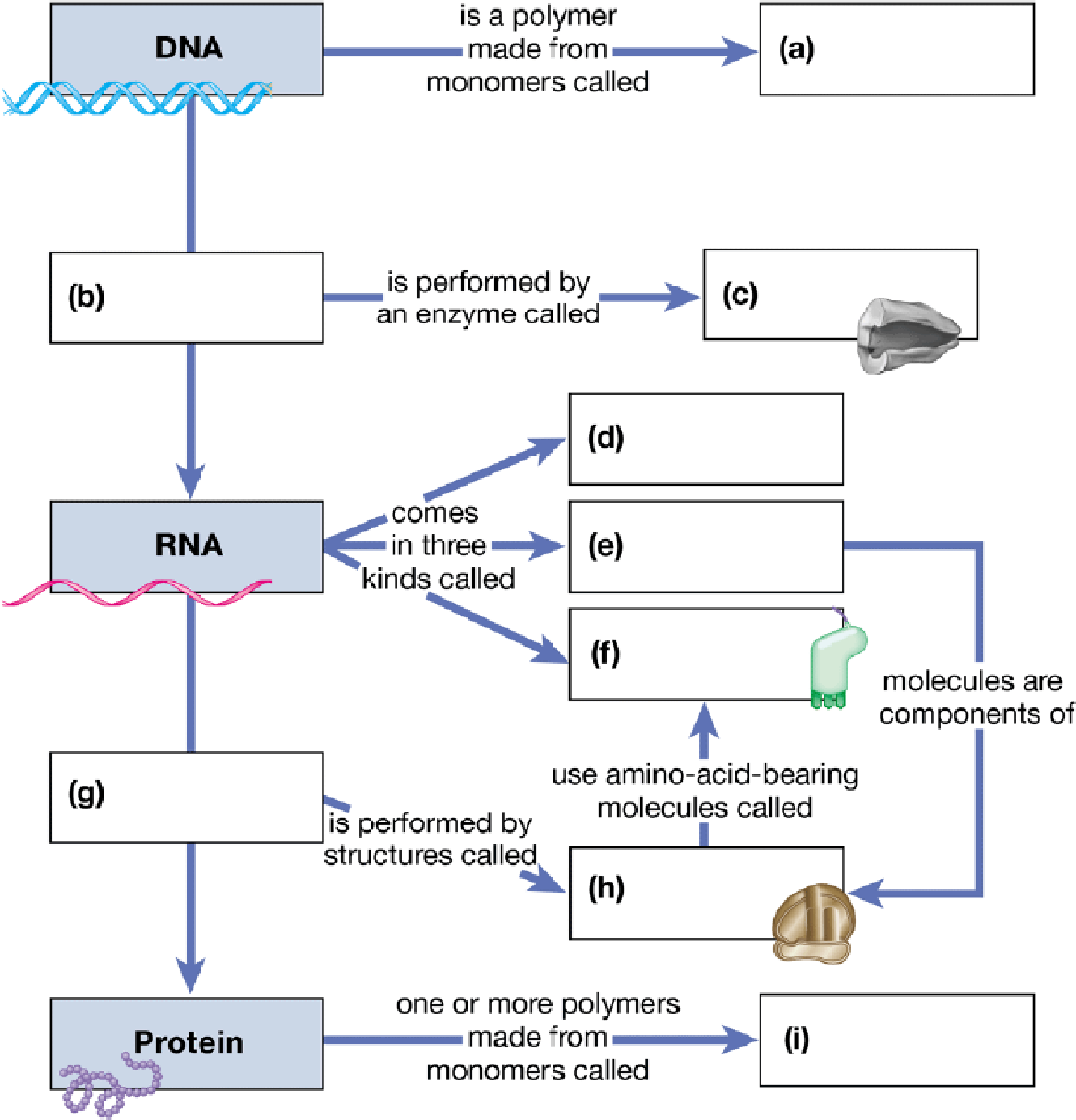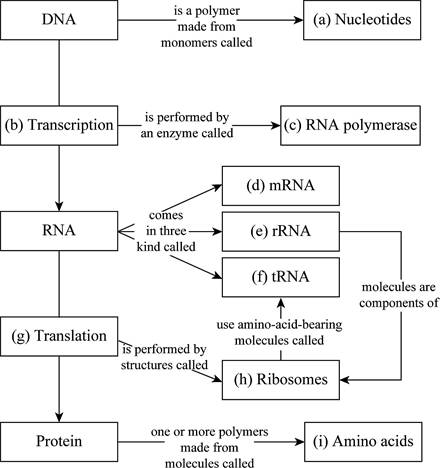
Concept explainers
Check your understanding of the flow of genetic information through a cell by filling in the blanks.

To complete: The given map showing the flow of genetic information through a cell.
Introduction: DNA is the blueprint of life. The genetic information of DNA is based in the nucleotide base sequences. These sequences are transcribed into mRNA triplets. These triplets of nucleotides are known as codons and they form the genetic code. They code for specific amino acids for the synthesis of proteins is known as functional gene products. This is known as gene expression.
Answer to Problem 1CC
Pictorial representation: Fig. 1 shows the completed map of flow of genetic information through a cell.

Fig.1 Flow of genetic information through a cell
Explanation of Solution
(a)
Correct answer: Nucleotides.
Explanation: The nucleotides are the building blocks of nucleic acids (DNA and RNA). DNA is a polymer made up of nucleotide monomers (adenine, thymine, cytosine, and guanine) and also known as polynucleotide. Hence, the correct answer is nucleotides.
(b)
Correct answer: Transcription.
Explanation: DNA consists of genetic instructions in the form of nucleotide sequences. It acts as a template and directs the messenger RNA (mRNA) synthesis in the cell. The process of formation of mRNA is known as transcription. Hence, the correct answer is transcription.
(c)
Correct answer: RNA polymerase.
Explanation: RNA polymerase enzymes are of three types out of which, RNA pol II transcribes mRNA. RNA pol II enzyme first binds to the transcription factors and then forms a complex with promoter at start codon for the beginning of transcription process. Hence, the correct answer is RNA polymerase.
(d)
Correct answer: mRNA.
Explanation: Both prokaryotes and eukaryotes consist of three types of RNA: mRNA, rRNA, and tRNA. mRNA forms 5% of the total RNA in a cell. mRNA consists of the genetic code in the form of triplets of nucleotides known as codons. Hence, the correct answer is mRNA.
(e)
Correct answer: rRNA
Explanation: rRNA forms 80% of the total RNA and is found in ribosomes. rRNAs along with proteins form ribosomes, which act as a site for protein synthesis. Hence, the correct answer is rRNA.
(f)
Correct answer: tRNA
Explanation: tRNAs are smallest among the three types of RNA. The mRNA sequence is read by transfer RNAs (tRNAs) to form polypeptide or a chain of amino acids in a process known as translation. The tRNA molecule with an attached amino acid binds to its specific mRNA codon. This mRNA codon codes for that specific amino acid. Hence, the correct answer is tRNA.
(g)
Correct answer: Translation.
Explanation: The mRNA acts as a template for the synthesis of polypeptide chain. Each letter in the gene sequence is copied which codes for a particular amino acid. The polypeptide chain is synthesized on the basis of amino acid sequences in the reading frame. This process is known as translation. Hence, the correct answer is translation.
(h)
Correct answer: Ribosomes.
Explanation: rRNAs along with proteins form ribosomes. Ribosomes act as a site of protein synthesis, that is, translation. Hence, the correct answer is ribosomes.
(i)
Correct answer: Amino acids.
Explanation: Amino acids are the monomer units of proteins. Amino acids are linked through peptide bonds to form a long polypeptide chain. Hence, the correct answer is amino acids.
Want to see more full solutions like this?
Chapter 10 Solutions
CAMPBEL BIOLOGY:CONCEPTS & CONNECTIONS
- In one paragraph show how atoms and they're structure are related to the structure of dna and proteins. Talk about what atoms are. what they're made of, why chemical bonding is important to DNA?arrow_forwardWhat are the structure and properties of atoms and chemical bonds (especially how they relate to DNA and proteins).arrow_forwardThe Sentinel Cell: Nature’s Answer to Cancer?arrow_forward
- Molecular Biology Question You are working to characterize a novel protein in mice. Analysis shows that high levels of the primary transcript that codes for this protein are found in tissue from the brain, muscle, liver, and pancreas. However, an antibody that recognizes the C-terminal portion of the protein indicates that the protein is present in brain, muscle, and liver, but not in the pancreas. What is the most likely explanation for this result?arrow_forwardMolecular Biology Explain/discuss how “slow stop” and “quick/fast stop” mutants wereused to identify different protein involved in DNA replication in E. coli.arrow_forwardMolecular Biology Question A gene that codes for a protein was removed from a eukaryotic cell and inserted into a prokaryotic cell. Although the gene was successfully transcribed and translated, it produced a different protein than it produced in the eukaryotic cell. What is the most likely explanation?arrow_forward
- Molecular Biology LIST three characteristics of origins of replicationarrow_forwardMolecular Biology Question Please help. Thank you For E coli DNA polymerase III, give the structure and function of the b-clamp sub-complex. Describe how the structure of this sub-complex is important for it’s function.arrow_forwardMolecular Biology LIST three characteristics of DNA Polymerasesarrow_forward
 Biology (MindTap Course List)BiologyISBN:9781337392938Author:Eldra Solomon, Charles Martin, Diana W. Martin, Linda R. BergPublisher:Cengage Learning
Biology (MindTap Course List)BiologyISBN:9781337392938Author:Eldra Solomon, Charles Martin, Diana W. Martin, Linda R. BergPublisher:Cengage Learning
 Human Biology (MindTap Course List)BiologyISBN:9781305112100Author:Cecie Starr, Beverly McMillanPublisher:Cengage Learning
Human Biology (MindTap Course List)BiologyISBN:9781305112100Author:Cecie Starr, Beverly McMillanPublisher:Cengage Learning Biology Today and Tomorrow without Physiology (Mi...BiologyISBN:9781305117396Author:Cecie Starr, Christine Evers, Lisa StarrPublisher:Cengage Learning
Biology Today and Tomorrow without Physiology (Mi...BiologyISBN:9781305117396Author:Cecie Starr, Christine Evers, Lisa StarrPublisher:Cengage Learning Human Heredity: Principles and Issues (MindTap Co...BiologyISBN:9781305251052Author:Michael CummingsPublisher:Cengage Learning
Human Heredity: Principles and Issues (MindTap Co...BiologyISBN:9781305251052Author:Michael CummingsPublisher:Cengage Learning





